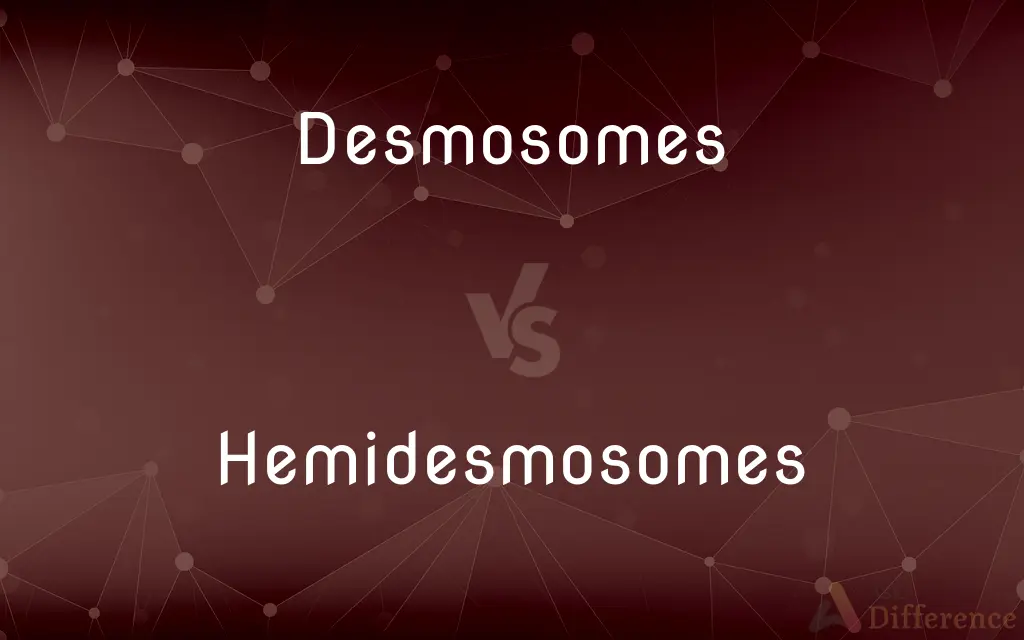Desmosomes vs. Hemidesmosomes — What's the Difference?
By Tayyaba Rehman & Urooj Arif — Published on February 2, 2024
Desmosomes are cell structures that link two cells together, while hemidesmosomes attach cells to the extracellular matrix.

Difference Between Desmosomes and Hemidesmosomes
Table of Contents
ADVERTISEMENT
Key Differences
Desmosomes and hemidesmosomes are both integral components of cellular adhesion, but they differ fundamentally in their roles and structures. Desmosomes are specialized structures that provide strong adhesion between adjacent cells, primarily found in tissues that experience mechanical stress, like the skin and heart. In contrast, hemidesmosomes are mainly involved in anchoring cells to the basement membrane, a type of extracellular matrix. This fundamental difference in function reflects their distinct roles in tissue integrity and organization.
In terms of structure, desmosomes are characterized by their disk-like shape and are composed of cadherins - a type of adhesion molecule - which facilitate the binding between adjacent cells. They also connect to intermediate filaments within the cell, providing structural support. Hemidesmosomes, on the other hand, are smaller and half-disk shaped. They primarily utilize integrins for connecting to the extracellular matrix and attach to intermediate filaments as well, but their composition and orientation differ significantly from desmosomes.
The molecular composition of desmosomes and hemidesmosomes also varies. Desmosomes primarily contain desmoglein and desmocollin, which are specific types of cadherins. These proteins interact with cytoplasmic plaque proteins like plakoglobin and desmoplakin, which in turn link to intermediate filaments. Hemidesmosomes, however, contain different types of integrins, like α6β4 integrin, that bind to laminin in the basement membrane. They also have distinct plaque proteins like plectin and BP230, which interact with intermediate filaments.
The distribution of desmosomes and hemidesmosomes within the body also highlights their differing functions. Desmosomes are predominantly found in tissues that undergo significant mechanical stress, such as the epidermis, cardiac muscle, and certain epithelial tissues. This distribution underscores their role in providing tensile strength and integrity to tissues. Hemidesmosomes, in contrast, are more commonly found in epithelial cells lining surfaces that interface with connective tissue, reflecting their role in securing these cells to underlying structures.
In terms of clinical relevance, abnormalities in both desmosomes and hemidesmosomes can lead to distinct pathological conditions. Mutations or dysfunctions in desmosomal proteins are often associated with skin diseases like pemphigus and certain cardiomyopathies. Hemidesmosome abnormalities, conversely, can result in conditions like bullous pemphigoid and epidermolysis bullosa, which are characterized by blistering due to impaired cell-matrix adhesion.
ADVERTISEMENT
Comparison Chart
Primary Function
Linking adjacent cells together
Attaching cells to the basement membrane
Structural Composition
Disk-like, containing cadherins
Half-disk shaped, containing integrins
Connection
To intermediate filaments
To intermediate filaments and the extracellular matrix
Location in Body
In tissues experiencing mechanical stress (e.g., skin, heart)
In epithelial cells lining interfaces with connective tissue
Associated Diseases
Pemphigus, certain cardiomyopathies
Bullous pemphigoid, epidermolysis bullosa
Compare with Definitions
Desmosomes
Desmosomes are characterized by their adhesive properties and resistance to mechanical stress.
The integrity of skin tissue during stretching is maintained by the resilience of desmosomes.
Hemidesmosomes
Hemidesmosomes are involved in cell-matrix adhesion, primarily using integrin proteins.
In wound healing, hemidesmosomes play a critical role in reattaching new cells to the matrix.
Desmosomes
Desmosomes function as cellular anchors, connecting cells through cadherin proteins.
In epithelial tissues, desmosomes play a key role in maintaining cell-to-cell adhesion.
Hemidesmosomes
Hemidesmosomes are half-desmosome structures facilitating adhesion to extracellular components.
The presence of hemidesmosomes is vital for the structural integrity of mucosal linings.
Desmosomes
Desmosomes are crucial for tissue integrity, especially in organs subject to mechanical forces.
Muscle tissues rely on desmosomes to maintain their cohesive structure during contraction and relaxation.
Hemidesmosomes
Hemidesmosomes provide tissue stability by connecting cells to the extracellular matrix.
Hemidesmosomes contribute to the firm attachment of nail cells to their underlying structures.
Desmosomes
Desmosomes are cell structures that provide mechanical strength by linking adjacent cells together.
Desmosomes are crucial in heart tissue, ensuring cells remain connected during heartbeats.
Hemidesmosomes
Hemidesmosomes are essential for the mechanical resilience of epithelial tissues.
In the cornea, hemidesmosomes help maintain transparency and structural integrity.
Desmosomes
Desmosomes are intercellular junctions that facilitate communication and structural stability.
The robustness of desmosomes aids in the coordinated activity of cardiac cells.
Hemidesmosomes
Hemidesmosomes are cellular structures that anchor epithelial cells to the basement membrane.
Hemidesmosomes ensure the stability of skin cells by attaching them to the underlying layers.
Desmosomes
Plural of desmosome
Hemidesmosomes
Plural of hemidesmosome
Common Curiosities
What are desmosomes?
Desmosomes are cellular structures that link adjacent cells together for mechanical strength.
What proteins are involved in desmosomes?
Desmosomes contain cadherins, plakoglobin, and desmoplakin, connecting to intermediate filaments.
What diseases are associated with desmosome dysfunction?
Desmosome abnormalities can lead to pemphigus and cardiomyopathies.
What proteins are key in hemidesmosomes?
Hemidesmosomes primarily contain integrins like α6β4 and proteins like plectin.
Do desmosomes contribute to cell communication?
Yes, desmosomes facilitate communication and coordination between cells.
Can hemidesmosome-related diseases be genetic?
Yes, genetic mutations can lead to diseases like epidermolysis bullosa.
Where are hemidesmosomes typically located?
Hemidesmosomes are located in epithelial cells interfacing with connective tissue.
Can hemidesmosomes affect wound healing?
Yes, hemidesmosomes are crucial in reattaching cells during wound healing.
Where are desmosomes commonly found?
Desmosomes are found in tissues experiencing mechanical stress, like skin and heart.
What are hemidesmosomes?
Hemidesmosomes are structures that anchor cells to the basement membrane.
How do desmosomes and hemidesmosomes differ?
Desmosomes connect cells to each other, while hemidesmosomes attach cells to the matrix.
What conditions result from hemidesmosome defects?
Hemidesmosome defects can cause bullous pemphigoid and epidermolysis bullosa.
Are desmosomes and hemidesmosomes visible under a microscope?
Yes, both can be observed under electron microscopy due to their distinct structures.
Are there any therapies targeting desmosomes?
Treatments for conditions like pemphigus may target desmosomal proteins.
Do desmosomes and hemidesmosomes evolve over time?
Yes, these structures can adapt in response to changes in tissue mechanics and cellular environment.
Share Your Discovery

Previous Comparison
Avogadro’s Constant vs. Avogadro’s Number
Next Comparison
HashMap in Java vs. HashSet in JavaAuthor Spotlight
Written by
Tayyaba RehmanTayyaba Rehman is a distinguished writer, currently serving as a primary contributor to askdifference.com. As a researcher in semantics and etymology, Tayyaba's passion for the complexity of languages and their distinctions has found a perfect home on the platform. Tayyaba delves into the intricacies of language, distinguishing between commonly confused words and phrases, thereby providing clarity for readers worldwide.
Co-written by
Urooj ArifUrooj is a skilled content writer at Ask Difference, known for her exceptional ability to simplify complex topics into engaging and informative content. With a passion for research and a flair for clear, concise writing, she consistently delivers articles that resonate with our diverse audience.
















































